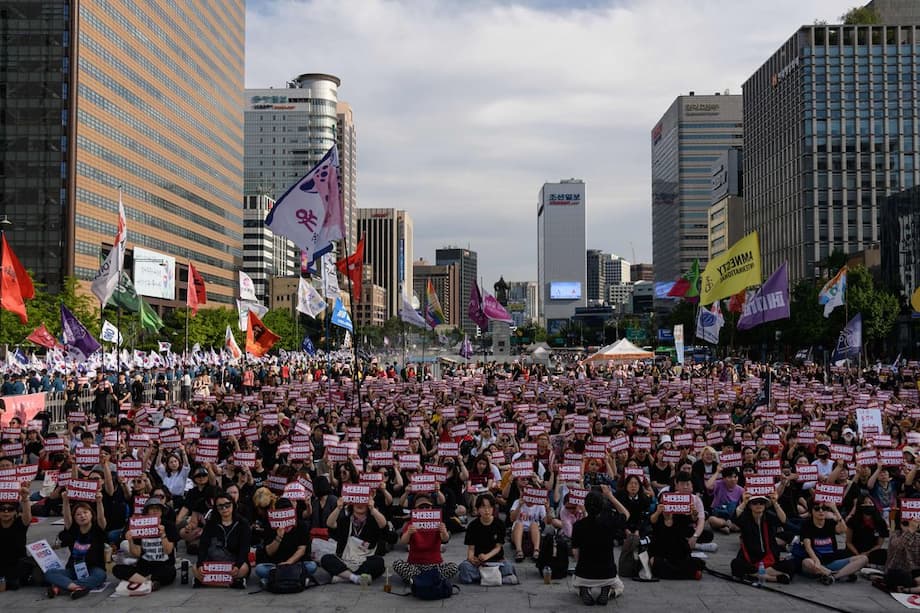Inside a legal gray zone: rights without access
Six years after South Korea’s Constitutional Court ruled that criminal penalties for abortion were unconstitutional, the country still lacks clear rules for how, when, and where people can end a pregnancy safely. Abortion is no longer a crime, yet it also is not fully regulated medical care. Hospitals often turn patients away because the Maternal and Child Health Act only contemplates limited exceptions tied to cases like rape and incest. Patients who do not meet those narrow conditions face a choice between expensive surgery at a small number of willing clinics or purchasing unapproved pills on the internet without medical guidance. The result is a system that recognizes a right to decide in principle while leaving many people without safe and affordable options in practice.
- Inside a legal gray zone: rights without access
- Why the abortion pill matters in medical care
- Regulators say they need a law before approval
- What proposed bills would change
- Who bears the burden today
- Human rights advocates push for clarity, while opponents seek limits
- Late term controversies highlight the legal vacuum
- How Korea’s experience fits into global patterns
- What a workable system could include
- Key Points
The legal vacuum formed after the court ordered lawmakers to replace the old criminal framework by the end of 2020. Parliament did not pass a replacement, which left abortion decriminalized from January 2021 but without a regulatory pathway to care. Advocates describe this as a blind spot. The lack of official protocols, training, and insurance coverage discourages providers. Patients, including minors, low income families, and those outside major cities, face long travel, rising bills, and unreliable information. Many turn to underground markets where smuggled or counterfeit medication can cause complications.
Access to trustworthy information has also been constrained. The website of Women on Web, a nonprofit that supports medication abortion in countries with restricted services, was blocked in 2019 under the Pharmaceutical Affairs Act. In May 2024, a South Korean court rejected an appeal to lift that block. Civil society groups argue that the state has failed to create a safe pathway to legal care while also restricting online information that many rely on. Health officials say they must first build a regulatory and legal framework before changing drug policy, a stance that has kept the status quo in place for years.
Why the abortion pill matters in medical care
The center of the policy debate is mifepristone, a medication used with misoprostol to end early pregnancy. The combination has been used for decades in more than 90 countries and appears on the World Health Organization list of essential medicines. International health data associate medication abortion with strong safety outcomes, low rates of serious complications, and a significant reduction in unsafe procedures when integrated into clinical care. In South Korea, mifepristone is still not approved, which pushes many people toward surgery or unregulated pills.
What the medications do
Mifepristone blocks the hormone progesterone, which maintains a pregnancy. Misoprostol then causes the uterus to contract and expel its contents. In settings where the regimen is approved, clinicians and public health agencies provide clear guidance on eligibility, dosing, warning signs, and follow up. Many countries allow the regimen in early pregnancy, often up to 10 or 12 weeks, with clinical discretion for specific cases. Health systems integrate counseling and information on pain management and when to seek emergency care. When offered through regulated channels, the process is closely monitored and supported.
Safety and public health
Global data cited by physicians and rights groups indicate that the risk of serious side effects with medication abortion is typically under 0.5 percent. Health experts also note that access to approved pills lowers demand for surgical procedures and reduces reliance on unsafe methods. That is a critical consideration in South Korea, where provider capacity has been strained. The World Health Organization estimates that of the 73 million abortions each year worldwide, about 25 million are unsafe. Expanding supervised access to medication is widely seen by clinicians as a pragmatic way to reduce harm. In Korea’s current system, where unapproved pills circulate online, the lack of quality control creates preventable risks that regulation could address.
Regulators say they need a law before approval
The Ministry of Food and Drug Safety has not approved Mifegymiso, a combination of mifepristone and misoprostol made by LinePharma and widely used overseas. Hyundai Pharm signed an exclusive supply agreement with the manufacturer and filed product applications in 2021 and 2023, then submitted a third application in December 2024. According to ministry officials, the review cannot proceed to a final decision because lawmakers have not defined medication abortion as a legal medical service. Without legislation that sets guardrails such as allowable gestational age, clinical indications, and risk management requirements, regulators say they lack the legal basis to finalize efficacy, dosing, labeling, and post market surveillance plans.
The ministry has not opted for conditional approval or restricted use pathways for Mifegymiso. Officials say the decision requires social consensus and a legislative framework. The company acknowledges the difficulty of advancing approval before lawmakers act. For patients and providers, this stance maintains a Catch 22. Medicine cannot be approved until rules are set, and rules have not been set partly because the medicine is not yet in the system. The result is an under review status with no clear timeline for resolution.
What proposed bills would change
The policy debate shifted this summer as lawmakers introduced measures to recognize abortion by medication as a legal medical procedure. A notable proposal would amend the Maternal and Child Health Act to define abortion as termination of pregnancy by surgical or pharmaceutical methods, not solely under narrow exceptions. The bill also calls for national health insurance coverage, which would lower cost barriers that keep many people from timely care. Sponsors have argued for removing outdated requirements, such as spousal consent, and for aligning terms with international medical practice. The administration of President Lee Jae Myung has echoed this direction by placing abortion medication on its five year national policy agenda.
These measures seek to bring clarity to questions that have lingered since 2019. Decriminalization meant people would not face prosecution for ending a pregnancy. Legalization through health legislation would set standards for providers, define clinical eligibility, and establish payment and oversight. That distinction matters to clinicians, who need certainty to offer care without fear of professional sanctions or civil liability. It also matters to patients, who need predictable access, clear information, and affordable costs.
Who bears the burden today
In the absence of a functioning system, the burdens fall hardest on those with fewer resources. Adolescent patients, migrants, people with disabilities, and those living far from major hospitals face the steepest hurdles. Advocates and clinicians report rising costs for surgical procedures, with surveys showing that about 40 percent of patients paid more than one million won. That price tag can force delays, which in turn narrows options and increases medical complexity. An obstetrician at the National Medical Center has described abortion services as a luxury for many excluded from mainstream systems.
Provider shortages intensify the problem. A series of trainee doctor resignations reduced gynecology and obstetrics capacity in 2025, straining clinics that still accept abortion patients. Fewer trained providers and unclear professional protections make hospitals reluctant to add services. Meanwhile, the lack of formal approval for medication abortion means Korea cannot rely on a tool that many health systems use to bridge staffing gaps and expand care into primary clinics.
Human rights advocates push for clarity, while opponents seek limits
Human Rights Watch and domestic groups have pressed the government to codify access, approve medication abortion, and remove obstacles to reliable information. The National Human Rights Commission of Korea recommended in 2024 that mifepristone be introduced and designated as an essential medicine, aligning policy with World Health Organization standards. International medical voices, including physicians from Women on Web, frame abortion as a fundamental component of sexual and reproductive health that should not depend on income, location, or marital status.
Religious organizations and some professional groups oppose wider access or urge tighter limits. Catholic leaders recently delivered formal objections to lawmakers, calling for what they describe as harmony between fetal life and a woman’s self determination. They voiced strong opposition to any framework they believe would permit late term procedures and criticized applying national health insurance to abortion care. These positions have shaped public hearings and are likely to influence how legislative committees revise or slow the bills.
Late term controversies highlight the legal vacuum
The lack of clear statutes has already produced flashpoint cases that inflame public debate. A vlogger’s claim in 2024 that she ended a pregnancy at 36 weeks triggered a police investigation and widespread controversy. Experts noted that while abortion crimes expired with the old criminal code, homicide charges could still be tested if evidence suggested a live birth. In 2025, a doctor was arrested in connection with a nine month termination, drawing fresh attention to the absence of defined gestational limits and clinical rules. These dramatic cases are rare, yet they reveal a system where sensational incidents can drive policy conversations more than routine patient needs. For clinicians, the takeaway is uncertainty. For patients, it is fear that seeking care could draw unwanted scrutiny or that a provider will refuse at the last minute.
How Korea’s experience fits into global patterns
South Korea’s struggle mirrors a broader trend. Across the world, countries that decriminalize abortion without building a health care framework often see uneven access, confusion among providers, and growth in unregulated markets. In Latin America, for example, some countries have moved to clear statutory models with defined timelines and reasons for care, while others retain severe restrictions. Even where abortion is permitted, practical hurdles like provider reluctance, documentation rules, and weak clinic networks can block care. What separates safer systems from unsafe systems is consistent guidance for providers, legal protections, and reliable coverage that reduces delays.
Telemedicine data support the view that demand persists regardless of restrictions. A retrospective study of consultations submitted to Women on Web from South Korea between 2013 and 2019 counted more than 12,000 requests, with a median age of 25 and a median gestational age of just over five weeks. People cited financial hardship, wanting to continue education, and lack of readiness to parent as leading reasons. Researchers concluded that restrictive rules do not stop abortion. They shift care into private and often less safe channels, which is precisely what lawmakers say they want to avoid.
What a workable system could include
Lawmakers have several models to consider. Countries that have integrated medication abortion establish clear gestational limits for routine use, standardized dosing and follow up, and referral pathways for complications. They clarify conscientious objection rules for individual clinicians while ensuring that institutions maintain service availability. They support training across primary and specialty care so patients can seek help close to home. They also protect patient privacy and offer counseling for those who want it without making counseling a barrier to timely care.
For South Korea, experts point to a short list of priorities. Define abortion as a medical service delivered by surgical or pharmaceutical methods. Approve mifepristone and misoprostol with clear clinical guidance. Cover services under national health insurance to prevent cost from becoming a de facto barrier. Issue provider protections, so hospitals can build services without fear of legal exposure. Establish accurate public information channels and address the online information gap created by blocking trusted resources. Align digital policy with health goals, so people can access reliable guidance instead of turning to risky sources. None of these steps requires a cultural consensus about every moral question. They require the government to set rules that make care safe, predictable, and transparent.
Key Points
- Abortion was decriminalized in 2021 after a 2019 court ruling, but there is still no comprehensive health law for abortion care.
- Mifepristone remains unapproved. Regulators say they need a legal framework before deciding on the drug.
- Lawmakers have proposed amending the Maternal and Child Health Act to recognize medication abortion and cover it under national health insurance.
- Unsafe and unregulated pills circulate online, while surgical costs have risen, with about 40 percent of patients paying over one million won.
- Provider shortages, worsened by trainee doctor resignations, limit access to gynecology services.
- Human rights bodies urge approval and regulation of abortion pills. Catholic groups and some medical voices oppose broader access or call for strict limits.
- High profile late term cases underline the legal vacuum and fuel public controversy.
- Global evidence shows medication abortion has a low rate of serious complications and reduces unsafe procedures when regulated.
- A workable system would set clinical standards, approve medication, provide insurance coverage, protect providers, and ensure reliable public information.




